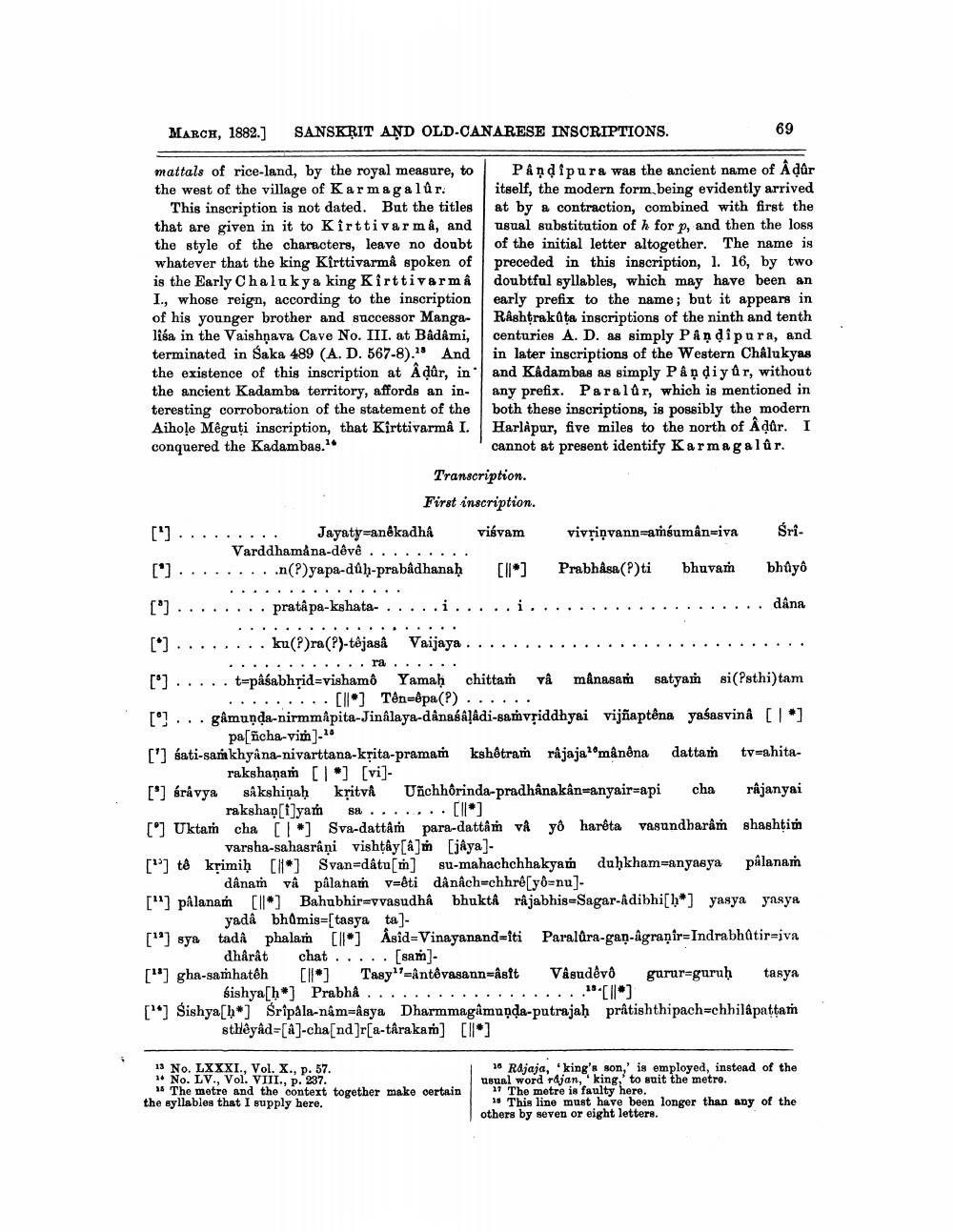________________
MARCH, 1882.]
mattals of rice-land, by the royal measure, to the west of the village of Karmagalûr.
This inscription is not dated. But the titles that are given in it to Kirttivarmâ, and the style of the characters, leave no doubt whatever that the king Kirttivarmâ spoken of is the Early Chalukya king Kirttivarmâ I., whose reign, according to the inscription of his younger brother and successor Mangalisa in the Vaishnava Cave No. III. at Bâdâmi, terminated in Saka 489 (A. D. 567-8). And the existence of this inscription at Adûr, in the ancient Kadamba territory, affords an interesting corroboration of the statement of the Aihole Mêguți inscription, that Kirttivarmâ I. conquered the Kadambas.1
ΞΞΞΞΞΞΞΞΞΞΞΞ
SANSKRIT AND OLD-CANARESE INSCRIPTIONS.
Transcription.
First inscription.
viśvam
Jayaty-anêkadhâ Varddhamana-dêvê . .
[*] śrâvya
.n(?)yapa-dûh-prabâdhanaḥ
Pandipura was the ancient name of  dûr itself, the modern form being evidently arrived at by a contraction, combined with first the usual substitution of h for p, and then the loss of the initial letter altogether. The name is preceded in this inscription, 1. 16, by two doubtful syllables, which may have been an early prefix to the name; but it appears in Rashtrakuta inscriptions of the ninth and tenth centuries A. D. as simply Pandipura, and in later inscriptions of the Western Châlukyas and Kadambas as simply Pân diyûr, without any prefix. Paralûr, which is mentioned in both these inscriptions, is possibly the modern Harlapur, five miles to the north of Adûr. I cannot at present identify Karmagalûr.
[*]
vivriņvann-amsumân=iva
69
Prabhina(?)ti bhuvam
pratapa-kahata
ku(?)ra(?)-tėjas Vaijaya
ra...
[*] t-pâśabhṛid-vishamô Yamah chittam vâ mânasam satyam satyah si(?sthi) tam ....[|*] Tên=êpa(?)...
13 No. LXXXI., Vol. X., p. 57.
1 No. LV., Vol. VIII., p. 237.
15 The metre and the context together make certain
the syllables that I supply here.
... gamunda-nirmmApita-JinAlaya-dânséâlâdi-samhvṛiddhyai vijiaptêna yasaavina [1]
Tasy"-ântêvasann-âsît
Śrî
büyü
dâna
pa[ficha-vim]
['] sati-samkhyana-nivarttana-krita-pramam kshetram rajaja1mânêna dattam tv-ahitarakshanam [*] [vi]
cha rajanyai
sâkshiṇaḥ kritvå Unchhbrinda-pradhânakin-anyair-api rakshan[]ynth sa.
... [*]
[] Uktam cha [*] Sva-dattâm para-dattâm và yo harêta vasundharam shashtim varsha-sahasrâni vishțây[â]m [jaya]
[] tê krimiḥ [*] Svan-dâtu[m] su-mahachchhakyam duḥkham-anyasya pâlanaṁ dânam và pâlanamv=-ti dânách=chhrê[yô=nu
["] pâlanaṁ [*] Bahubhir=vvasudha bhuktâ râjabhis-Sagar-Adibhi[h] yasya yasya yada bhamis=[tasya ta]
[1] sya tada phalam [*] Asid-Vinayanand-iti Paralûra-gan-âgranîr=Indrabhûtir=iva
dhârât chat. . . . . [sam]
["] gha-samhatêh
sishya[h] Prabhâ. . [] Sishyn[b] Sripala-nam-Asya Dharmmagimupda-putrajab pratishthipachchhilāpaṭṭath sthêyâd-[a]-cha[nd]r[a-târakam] [*]
Visudêvô gurur-guruḥ tasya .15-[11]
18 Rajaja, king's son,' is employed, instead of the usual word rajan, king, to suit the metre.
17 The metre is faulty here.
18 This line must have been longer than any of the others by seven or eight letters.




